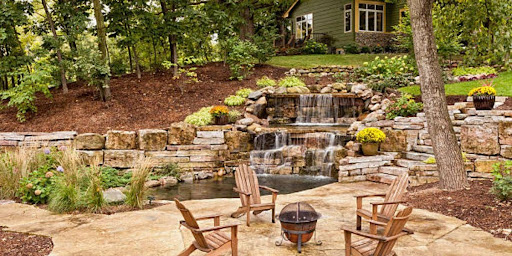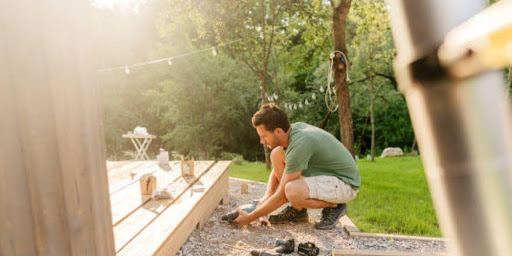Power Articles
Industry Elevating Content
Transforming Outdoor Living Spaces: Patio Renovation Guide

PowerArticles
Mar. 4, 2024
Welcome to the Patio Renovation Guide, where we dive into the art of transforming outdoor living spaces. As exterior home improvement companies, understanding the nuances of patio renovation is crucial in enhancing the appeal and functionality of outdoor areas for homeowners. This guide aims to equip you with practical insights and strategies to revitalize patios, creating inviting and enjoyable spaces for relaxation, entertainment, and family gatherings. From selecting the right materials to maximizing layout efficiency and incorporating trendy design elements, let’s embark on a journey to elevate outdoor living experiences through thoughtful renovation practices.
Assessing Current Patio Conditions
Before embarking on any renovation project, it’s essential to assess the current state of the patio thoroughly. This involves three main steps:
A. Inspecting Structural Integrity: Begin by examining the structural components of the patio, such as beams, columns, and foundations. Look for signs of wear and tear, such as cracks, rust, or rot, which could compromise the stability of the structure.
B. Evaluating Surface Materials: Next, assess the condition of the surface materials, whether it’s concrete, pavers, wood, or tiles. Check for cracks, stains, or uneven surfaces that may detract from the patio’s aesthetics or pose safety hazards.
C. Identifying Areas for Improvement: Finally, identify any areas that require improvement or updates based on the client’s preferences and the overall functionality of the space. This could include adding features like outdoor kitchens, fire pits, or seating areas, or addressing drainage issues to prevent water accumulation.
Setting Renovation Goals
With a clear understanding of the patio’s current condition, the next step is to establish renovation goals in collaboration with the client. This involves:
A. Defining Client Expectations: Engage in open communication with the client to understand their vision for the renovated patio. Discuss their lifestyle, preferences, and desired functionalities to ensure the renovation aligns with their needs.
B. Establishing Budget and Timeline: Work with the client to establish a realistic budget and timeline for the renovation project. Consider factors such as the scope of work, materials cost, and labor expenses to avoid unexpected delays or overspending.
C. Selecting Design Elements: Collaborate with the client to select design elements that complement the overall aesthetic of the property. This includes choosing materials, colors, patterns, and features that enhance the beauty and functionality of the patio while reflecting the client’s style preferences.

Planning the Renovation Process
Once renovation goals are established, it’s essential to create a comprehensive plan to guide the project from start to finish. This involves:
A. Obtaining Necessary Permits: Depending on the scope of the renovation, it may be necessary to obtain permits from local authorities before commencing work. Ensure all necessary permits are obtained to avoid legal complications down the line.
B. Creating a Detailed Project Plan: Develop a detailed project plan outlining the sequence of tasks, milestones, and deadlines for the renovation. Assign responsibilities to team members and subcontractors to ensure smooth coordination and execution of the project.
C. Securing Required Materials and Equipment: Procure all necessary materials, tools, and equipment needed to complete the renovation according to the project plan. Coordinate deliveries and logistics to ensure everything is in place when needed, minimizing delays and disruptions.
Implementing Structural Changes
With the planning phase complete, it’s time to execute the renovation by implementing structural changes as needed. This involves:
A. Repairing or Replacing Damaged Elements: Address any structural deficiencies identified during the assessment phase by repairing or replacing damaged elements. This could include reinforcing foundations, repairing cracked concrete, or replacing deteriorated wood.
B. Enhancing Stability and Safety Measures: Incorporate measures to enhance the stability and safety of the patio, such as installing railings, adding support beams, or reinforcing load-bearing structures. Ensure all enhancements comply with building codes and safety standards.
C. Incorporating Structural Upgrades: Finally, consider incorporating structural upgrades to improve the functionality and longevity of the patio. This could include installing drainage systems, waterproofing membranes, or energy-efficient lighting solutions to enhance usability and comfort.

Upgrading Surface Materials
Outdoor living spaces are greatly defined by their surfaces, making it crucial to select the right materials for your patio renovation project.
A. Choosing appropriate flooring options: When upgrading outdoor surfaces, consider materials that withstand varying weather conditions and foot traffic. Popular options include durable hardwood, resilient composite decking, versatile concrete, and natural stone like slate or flagstone. Each material offers distinct aesthetics and maintenance requirements, so assess factors like cost, durability, and visual appeal before making a decision.
B. Exploring various surface finishes: Surface finishes play a significant role in the overall look and feel of your patio. Textured finishes provide better traction, reducing the risk of slips and falls, while polished finishes offer a sleek and modern appearance. Additionally, consider stamped concrete for mimicking the look of natural stone or decorative patterns, enhancing visual interest without the high cost.
C. Installing low-maintenance and durable materials: Opting for low-maintenance materials ensures longevity and ease of upkeep for homeowners. Look for materials resistant to fading, staining, and warping, such as composite decking or porcelain pavers. These materials require minimal cleaning and sealing, making them ideal for busy outdoor spaces while maintaining their aesthetic appeal for years to come.
Adding Functional Elements
Functional elements transform an ordinary patio into a versatile outdoor oasis, providing comfort and convenience for homeowners and their guests.
A. Introducing seating and dining areas: Incorporate comfortable seating options like lounge chairs, sofas, or built-in benches to create inviting gathering spots. Consider the layout of the space and the number of people it will accommodate when selecting furniture. Additionally, include a dining area equipped with a sturdy table and chairs for al fresco dining experiences.
B. Incorporating outdoor kitchen features: Elevate the outdoor cooking experience by integrating kitchen amenities like grills, countertops, sinks, and storage cabinets. An outdoor kitchen enhances entertainment opportunities and encourages outdoor living year-round, providing a convenient space for preparing meals and hosting gatherings.
C. Installing lighting and heating solutions: Extend the usability of outdoor spaces into the evening and cooler months with strategic lighting and heating installations. Illuminate pathways, seating areas, and architectural features with overhead lighting, wall sconces, or ground-level fixtures. Incorporate heating elements like fire pits, outdoor fireplaces, or patio heaters to create a cozy ambiance and extend outdoor enjoyment even during colder seasons.

Enhancing Aesthetic Appeal
Elevate the visual appeal of outdoor living spaces by integrating elements that reflect the homeowner’s style and preferences.
A. Selecting landscaping and greenery: Integrate lush landscaping, trees, shrubs, and flowers to soften hardscape surfaces and add natural beauty to the patio area. Choose plants that thrive in the local climate and require minimal maintenance to ensure long-term vitality and visual appeal.
B. Incorporating decorative elements: Enhance the ambiance of outdoor spaces with decorative elements like water features, sculptures, or outdoor artwork. These focal points add visual interest and personality to the patio, creating a unique and inviting atmosphere.
C. Personalizing the space to reflect client preferences: Tailor the design of the patio to align with the homeowner’s lifestyle, preferences, and aesthetic sensibilities. Consider factors such as color schemes, furniture styles, and decorative accents to create a cohesive and personalized outdoor retreat that reflects the client’s personality and taste.

Conclusion
Renovating outdoor living spaces like patios can greatly enhance a home’s appeal and functionality. By focusing on durable materials, versatile layouts, and eco-friendly features, exterior home improvement companies can help homeowners create inviting and enjoyable spaces for relaxation and entertainment. Providing personalized design options and emphasizing the benefits of low-maintenance solutions can further attract customers. Ultimately, through attention to detail and understanding the unique needs of each homeowner, patio renovations can transform outdoor areas into cherished extensions of the home, adding significant value and satisfaction to the overall living experience.
Published By
PowerArticles
Mar. 4, 2024